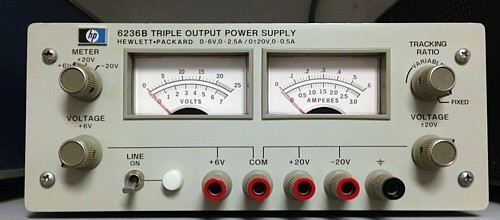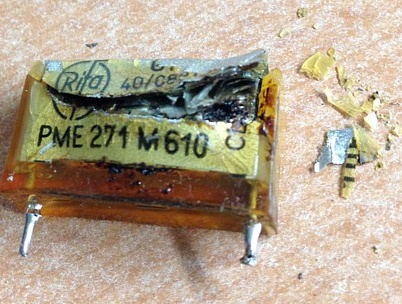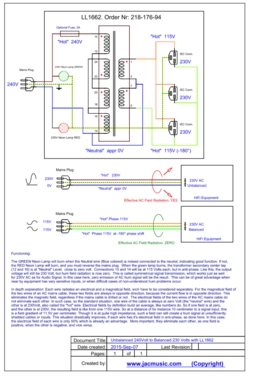Today my Hewlett Packard 6236B power supply went up in Smoke
Some think we have 230V mains in Europe, but if you have a voltmeter, you will see it is often 235V and sometimes close to 240V. When equipment or parts have only 5% voltage tolerance, that is nothing unusual. 99.99% of all electron tubes ever made, are like that. But 220V and 240V are 10% apart. So here is what can happen:

6236B power supply
- This is a nice item, because it works all analog, it is so tiny, and also because it has a fold back characteristic when you overload it. So at overload it does not go into current limiting mode, but into very low current mode, like an electronic fuse.
- Myself I just like it, because it's small size, and no digital "beep...beep" when you change the settings, and the meters are accurate. Others prefer them because there is no digital switch noise radiating out of it.
- They are easy to repair. No integrated circuits, everything is made such that you can understand how it works even without service manual. So you can check things easily, and calibration is done quickly and easy.
The only thing they seem to need, is cleaning of the meter glass (plastic) from the inside, which becomes a bit shady, but it's only a dirt layer at the inside. This is a bit tricky as it is clipped together, and the meters were not intended to open, but it is possible. If done so, the meters look like new again. Once the meters were removed, I polished the glass also from the outside (with car polish). This really payed off. Well, whatever the reason for wanting to have those, the buyers at Ebay know it, and these go for remarkable prices, even in bad condition.
Much to my surprize, one day, it produced a massive amount of fat smoke, a switching on. It was so incredible much smoke, you would never believe it can come so quickly out of such a tiny device!
It was fully clear to me, the whole PCB was totally burned, or the transformer was melted. I had to open the windows to get rid of the smoke, and it still smelled like burned paper the next day here.
Curiously when opening the power supply, I could not find the source of the smoke. So what to do? Take a variac and slowly increase the voltage, and sure the smoke will appear again. To my surprize, nothing happened, and even more surprisingly, the power supply turned on normally, and worked just fine.
After a lot of searching I finally found the problem source, it was mounted almost against the mains transformer, and the crack was invisible that way.
 This capacitor was directly mounted across the mains, used as a filter to keep spikes from the mains away from the power supply. This is probably a good idea, but being an old analog designer, a red warning lamps began to burn in my head. I really have a very high opinion about analog designs from Hewlett Packard, but mount a 250V rated capacitor directly on the 220V mains, that is a thing I would forbid designers to do, when it was my responsibility. To my opinion there must be a protection resistor in series. Of course, you can easily calculate the AC blind current from this and with the low value of 1uF that is very little current. Moreover this is a special type capacitor, made for exactly this application, they say at Rifa in the datasheet. Still I would never have done so, because when you switch on the power supply, coincidently when the mains is at a peak, the momentary value is 317 Volt, and the capacitor is empty. To make visible, what kind of current spike that causes, all you need to do, charge the capacitor with 317 Volt DC, and discharge it by using a piece of mains cable, same as which is used to connect the power supply to the mains. The result is an aggressive, blue spark. I don't know the current exactly, but it's 100's of Ampere. Sorry, I don't try to know things better, but I remember when I worked in R&D I used a simple device which I build myself, and it switched on and off the mains, with a big, clunky relay, with a rate of 1x per 20 seconds. I mean this is what happens when users switch on the device. To simulate that over a life time, just let that run for a day, with the device in an oven at 50°C. Often something gets defective from that. Not saying it MUST survive this, but you do need an explanation of course, if something gets defective, why that was so. Most of the time that does kill some electronic parts, and it unveils those situations where you thought "it should be ok", but it was appearantly not so. This test may have found the under rated capacitor.
This capacitor was directly mounted across the mains, used as a filter to keep spikes from the mains away from the power supply. This is probably a good idea, but being an old analog designer, a red warning lamps began to burn in my head. I really have a very high opinion about analog designs from Hewlett Packard, but mount a 250V rated capacitor directly on the 220V mains, that is a thing I would forbid designers to do, when it was my responsibility. To my opinion there must be a protection resistor in series. Of course, you can easily calculate the AC blind current from this and with the low value of 1uF that is very little current. Moreover this is a special type capacitor, made for exactly this application, they say at Rifa in the datasheet. Still I would never have done so, because when you switch on the power supply, coincidently when the mains is at a peak, the momentary value is 317 Volt, and the capacitor is empty. To make visible, what kind of current spike that causes, all you need to do, charge the capacitor with 317 Volt DC, and discharge it by using a piece of mains cable, same as which is used to connect the power supply to the mains. The result is an aggressive, blue spark. I don't know the current exactly, but it's 100's of Ampere. Sorry, I don't try to know things better, but I remember when I worked in R&D I used a simple device which I build myself, and it switched on and off the mains, with a big, clunky relay, with a rate of 1x per 20 seconds. I mean this is what happens when users switch on the device. To simulate that over a life time, just let that run for a day, with the device in an oven at 50°C. Often something gets defective from that. Not saying it MUST survive this, but you do need an explanation of course, if something gets defective, why that was so. Most of the time that does kill some electronic parts, and it unveils those situations where you thought "it should be ok", but it was appearantly not so. This test may have found the under rated capacitor.
What makes the situation worse, and the real reason I put this information here: The power supply had an internal switch for 220V or 240V mains, and it was set for 220V still. Though we had 235V already in 2002. Today we have often enough 238 Volts here, but this capacitor was mounted directly at the mains input, so setting the transformer from 220 to 240 doesn't protect the capacitor any better. Of course I still set that switch to 240V now, and I replaced the capacitor for another Rifa type, but now 400 Volt. It is twice the dimensions, and hopefully that won't give further problems now.
Conclusion: I learned myself the hard way, it is very unwise to plug 220V devices into the 235V mains. Check if there is a 240V option, and use it. If there is no such option, the Lundahl mains adapter transformers are a very good thing to use.
